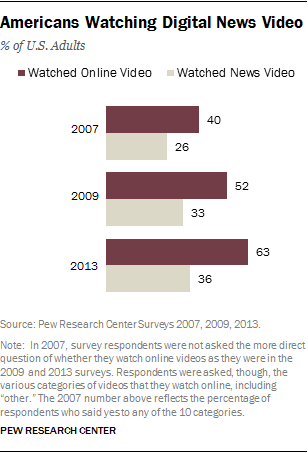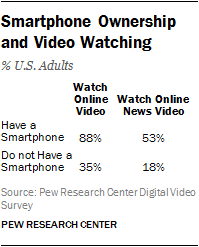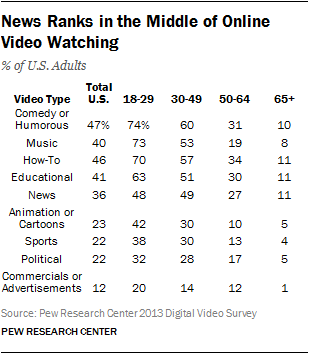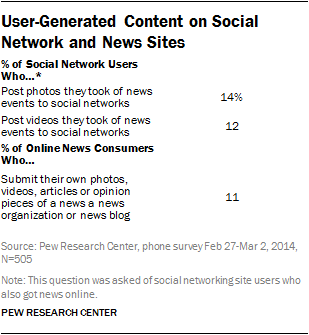
About six in ten U.S. adults (63%) watch online video, and over half of those – 36% in all – watch news videos online, according to a new analysis of Pew Research Center survey data. This is up from 40% of U.S. adults who watched or downloaded some kind of online video in 2007, and 26% who watched news videos online.3
To put those video watching numbers in context, it is worth remembering that YouTube wasn’t founded until 2005 and was purchased by Google in 2006. The first iPhone was released in 2007, and in-home broadband penetration that year was just 47%.
Most of this growth, though, occurred between 2007 and 2009. Since then, the rise in online video watching – and news video watching in particular – has slowed considerably. Looking ahead, some analysts expect the continued growth in mobile to spur another round of online video consumption. Indeed, in this survey, while we did not ask which device they watched videos on, smartphone owners were more than twice as likely to watch online videos and online news videos as non-smartphone owners.

Fully 88% of smartphone owners watch online videos, compared with 35% of those who do not have a smartphone. And more than half (53%) of smartphone owners watch news videos, compared with 18% of those who do not own a smartphone. Again, the survey did not ask which device respondents watched the videos on, so it does not indicate that this is necessarily smartphone news video watching. Other data, though, speak to growth in overall mobile video watching. Business Insider’s research division found that the mobile market’s share of online video traffic grew from 4% in January 2012 to 15% in September 2013.4
As is often the case with areas of new technology, younger generations are more likely than older ones to watch videos online. Nine in ten 18-to-29-year-olds (90%) watch online videos, compared with 80% of 30-to-49-year-olds, 49% of 50—to-64-year-olds and just 20% of those 65 or older.
What’s more surprising, perhaps, is the degree to which news is in the mix of what they watch. Fully, 48% of all 18-to-29-year-olds in the U.S. watch news videos online, roughly equal to the 49% of 30-to-49-year-olds who watch news videos online and substantially more than those 50 and older.

This speaks to the idea that there could be opportunities in the digital realm for young people to get news at similar rates as their older cohorts – something that has not been the case in most legacy news platforms like newspapers and television.

Those under 30 also watch a wide range of other kinds of online video. Comedy, music and how-to videos are most popular online, reaching 70% or more of this population each. But, news outpaces sports videos (38%) and politics (32%).
Two other demographics that stand out in online news video consumption more closely mirror broader news habits: education and income.5 More highly educated Americans are more likely to watch news video. About half of Americans with a college degree or higher watched news video online; this compares with 43% of those who have completed some college and only 22% of those with a high school degree or less.
More than half (57%) of Americans at the higher end of the income spectrum (more than $75,000 a year in household income) watch news videos online, compared with just 36% of those whose households bring in between $50,000 and $74,999 per year, 34% of those making between $30,000 and $49,999 per year, and 25% of those in households making less than $30,000 per year.
The Audience as Contributor
In addition to watching more digital videos, Americans are recording and sharing their own videos. As of July 2013, more than a third (36%) of U.S. adults reported recording videos on their cellphones. And news has become an important part of what they record.
New Pew Research survey data find that 12% of social media users post videos of news events that they themselves have taken on social media.6 And 11% of all online news consumers have submitted their own content (including videos, photos, articles or opinion pieces) to news websites or blogs. That amounts to 7% of U.S. adults posting their own news videos on social media and 7% submitting their own content to news sites.
While this is still a relatively small segment of the population, the impact has already proved powerful. More and more, citizens are capturing important eyewitness videos around breaking news events. In 2012, a Pew Research Center study found that more than one in three top news videos (39%) on YouTube were posted by citizens.

In 2013, user-generated video played an important role around breaking news and in situations of unrest where access is difficult for professional journalists. In the first 24 hours after a deadly tornado slammed into Moore, Okla., around 3 p.m. on May 20, citizen journalists produced a majority of the most-viewed YouTube videos. When Ukrainian protesters took to the streets of Kiev’s Independence Square in February 2014, numerous news organizations (particularly Russia Today) repackaged citizen content from the riots, melding the images into new products. And amid the chaos of the Boston Marathon bombings in April 2013, bystanders recorded the events, as they unfolded – including the initial blasts and the police chase that ended in Watertown, Mass., with one of the suspects dead and the other in custody.
Portals like YouTube, with one billion monthly viewers, or Vimeo, with 135 million unique viewers, are home to unfiltered and uncurated videos posted by the public, some of which capture news events.7 More and more, these videos are being incorporated into news reports or onto news websites. But the process for how news organizations and citizens share content is still evolving, with questions about how to provide proper attribution, how to verify the accuracy of videos, and even how to archive them for the future.
To that end, a number of startups have emerged – among them Stringwire, Storyful and Storyhunter – that exist to help curate and vet video content created by the public and freelancers, which can then be packaged for the web by news outlets.
Stringwire, acquired by NBC News in 2013, is a startup working to create a frictionless process by which user eyewitnesses can stream a news event from their cellphones straight to NBC editorial staff, which can then broadcast relevant content on the air or on the web. Storyful, launched in 2010 and purchased by News Corp. in 2013 for $25 million, works to verify citizen video uploaded to the web or to news sites. The company also secures licenses for news video it finds around the web and then sells those licenses. Storyhunter is a digital production studio that works with its network of independent and freelance video journalists to vet and produce high-quality news video. These and others build off earlier video curation and editing services, such as CNN’s iReport, which has gathered user-generated video, photo and narrative content, some of which have appeared on broadcasts.




